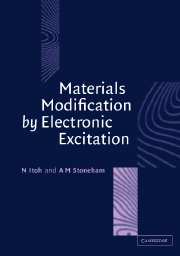Book contents
- Frontmatter
- Contents
- Preface
- 1 Concepts: Excitation, polarons and electronic structure
- 2 Energy deposition and redistribution in solids
- 3 Electron–lattice coupling and its consequences
- 4 Self-trapping
- 5 Local lattice modification by electronic excitation of halides
- 6 Local lattice modification by electronic excitation of crystalline insulating oxides
- 7 Local lattice modification of semiconductors by electronic excitation
- 8 Local lattice modification of amorphous materials by electronic excitation
- 9 Atomic emission and surface modification
- 10 Interface reactions induced by electronic excitation
- 11 High excitation intensities
- 12 Applications of materials modification by excitation
- References
- Index
11 - High excitation intensities
Published online by Cambridge University Press: 11 August 2009
- Frontmatter
- Contents
- Preface
- 1 Concepts: Excitation, polarons and electronic structure
- 2 Energy deposition and redistribution in solids
- 3 Electron–lattice coupling and its consequences
- 4 Self-trapping
- 5 Local lattice modification by electronic excitation of halides
- 6 Local lattice modification by electronic excitation of crystalline insulating oxides
- 7 Local lattice modification of semiconductors by electronic excitation
- 8 Local lattice modification of amorphous materials by electronic excitation
- 9 Atomic emission and surface modification
- 10 Interface reactions induced by electronic excitation
- 11 High excitation intensities
- 12 Applications of materials modification by excitation
- References
- Index
Summary
Introduction
So far, we have concentrated on situations in which the number of excitons is low, so that behaviour can be analysed in terms of individual electrons or holes, or excitons, or perhaps biexcitons or small exciton complexes. This type of description holds to modest levels of excitation. Thus Tanimura & Itoh (1988b, 1990) discussed exciton fusion, in which a free exciton and a self-trapped exciton in RbI transform to either an F–H pair or a luminescent singlet selftrapped exciton. Yet there are important cases for which this class of description is dubious. The numbers of excitons, or electrons and holes, can even be of the order of the number of atoms. Such a massive degree of excitation needs a different description. For example, the host interatomic forces will be changed severely. If, as a result, the host is unable to resist shear, a description in terms of a liquid state or a plasma is tempting. The energy per atom can easily be large enough to cause evaporation or exoelectron emission, with associated electric fields. In the cooling process, the system may evolve into a different solid structure, possibly a non-equilibrium form. In this chapter we discuss some of these situations. It is hardly surprising that we cannot give a detailed dynamical and microscopic picture of the behaviour. However, for practical applications, we can make do with less information.
- Type
- Chapter
- Information
- Materials Modification by Electronic Excitation , pp. 407 - 443Publisher: Cambridge University PressPrint publication year: 2000

